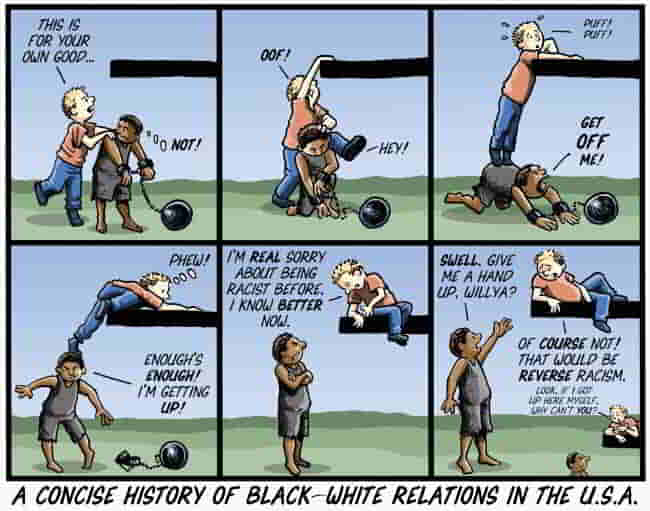The creator of the meme appears to be clueless about structural inequality. It’s possible however that the person, rather than being clueless, created this to appeal to a Nepalese audience that s/he knows well! Or, there maybe a completely different explanation for why the individual might have created a meme that’s obviously so wrong!
Here, to begin with, is the translation.
In a country where Kalyan Shrestha, the son of a Newar [a Janjati], is the Chief Justice of the Supreme Court, tell me, where is ethnicity-based discrimination? In a country where the son of a Yadav [a Madhesi] can be a President, tell me, where is ethnicity-based discrimination? In a country where the son of a Nembang [a Janjati] becomes the Speaker of The House, tell me, where is ethnicity-based discrimination? A son of a Bahun [high caste] slogs it out in 50 degree heat in the Gulf, how is he a member of the country’s ruling class? Friends, put your efforts into improving your skills instead of being envious of others. When you were of school-going age you wasted your time playing marbles and other such games, smoking weed and cigarettes, teasing young girls and failing in several subjects and now you kick up a stink because you can’t get a high-ranking post in the government? Let’s not get into such posts by begging for affirmative action but through earned qualification and proven ability!!
Of course the logic is completely off — you cannot make such a gross generalisation from one single example!
One example does not make a rule; one exception does not break a rule.
Kalyan Shrestha, the current Chief Justice, might be a Janjati and not a hill so-called high caste Hindu — a Khas or Khas Arya (a Bahun or a Chhetri). But, how many of the supreme court justices, to date, have NOT been Khas? Only 22%, a minority!
According to a Kantipur article published today and written by a Bahun, former Chief Election Commissioner Bhoj Raj Pokharel, the combined representation of non-Khas-Arya in a number of government executive bodies is only 24%.
Non-Khas made up only between 5 and 33% of Prime Ministers, Chief District Officers, the last Council of Ministers and Bar Association office bearers, for instance.
The percentage of women have been even smaller. Pokharel finds women’s representation to be only 6%!
In other words, a majority of them are Khas men who make up roughly 15% of the population.
The reason is structural inequality inherent in our society which disproportionately benefits Khas men, giving them considerable structural privileges. Structural inequality has been — and continues to be — maintained by the privileged through systemic and institutional discrimination.
Structural inequality inherent in our society disproportionately benefits Khas men. Click To TweetThat however does NOT mean that ALL Khas people are privileged AND NO ONE from the rest of the population is at all. Neither does that mean that ALL Khas people are wealthier than the rest of the population.
Furthermore, not all structurally privileged are wealthy nor are the rest all poor. That’s why you can find poor Khas men slogging “it out in 50 degree heat” in the Gulf just as you can find highly successful and extremely wealthy non-Khas Nepalese in Australia, Russia etc. Heck, absolute numberwise, we most likely have more poor Khas people than poor Dalits!
BUT of course the existence of poor high-caste Hindus is NOT evidence for the absence of systemic and institutional discrimination of Janjatis, Dalits and Madhesis, to say nothing of discrimination of women.
(In the Nepal this person appears to live, women don’t seem to even exist, not unlike in a similar meme I wrote a satirical piece about! How else do you explain examples involving only sons?! 😉 Telling, isn’t it? )
After going to such length to argue how there is no systemic and institutional discrimination in the country, towards the end, the creator tells us what s/he thinks of the non-Khas Nepalese. Nepalese not belonging to the ruling caste/class, to the creator of the meme, is … a low life!
In characterising others that way, this person unwitting has outed himself/herself, ironically, as a bigot!
The existence of poor Khas-Aryas is NOT evidence for absence of discrimination. Click To TweetAs for the call to apply oneself to get qualifications and acquire skills to make it into the power structure of the country instead of by “begging for affirmative action”…
Here, there is only an allusion to the hill so-called high caste Hindus being more qualified (educated) and skilled than others. I have encountered such arguments in the past — that Bahuns are more educated and/or competitive and/or considerably more hard working — as well as the argument that hill so-called high caste Hindus are more “deserving” of such posts. I find that very intriguing.
Let’s assume for argument’s sake that the Khas-Aryas in general are highly qualified and competent, especially those who run the government.
Then, how come we still have such a dinosaurian bureaucracy?!
And, how come we are still one of the least developed countries in the world?!
The sad irony is that, government posts in Nepal are some of the cushiest jobs you can get through connection (“afno manche“), ass kissing, patronage and nepotism, i.e. social capital, which the structurally privileged have in abundance.
The non-Khas Nepalese, on the other hand, lacking in social capital, have limited opportunities to compete for those posts regardless of their qualifications and skills.
In other words the disproportionately high representation of the Khas-Aryas in positions of power is achieved by the Khas-Aryas “reserving” those positions of power for themselves!
The image below, taken from the article “The Structure of Structural Inequality“, neatly summarises the history of race-relations in the US. Look closely enough and you’ll see that it provides some insight into the nature of the ingrained systemic and institutional discrimination in Nepal. All you have to do is ignore an element or two and do some mental juggling! 🙂
If you want more details, watch the YouTube video “Unequal Opportunity Race.” Once again, the video is about the history of the factors that contributed to the present-day structural inequality and racial discrimination in the US. If you watch the video, I am sure you’ll be able to draw parallels without too much effort.
What’s sad to see is that, in spite of the meme getting the logic and the characterisation of fellow Nepalese so completely wrong, it has appealed to — and misinformed — a sizeable Nepalese Facebook users. The last time I checked, it had been shared over seven thousand times with a vast majority of those I read agreeing with it.
(This isn’t the first Nepali meme I have written about. In another satirical post, I poke fun at the meme pitching the ultra-nationalists’ call for “Unity in Diversity.” Having noticed Nepalese struggling to make logical arguments, I also wrote a blog in which I argued that our curriculum should include philosophy.)
What are the chances that this blog post will reach even a fraction of those that the meme must have reached? Small!
Regardless, it’s important to put out and share information such as this. Information such as this discussing the kind of discourses we are having about the ills of our society, such as systemic and institutional discrimination and how it affects everyone, not just the victims, generates awareness and understanding.
At least, that’s my belief anyway. What do you think? Care to share below?
* * * * * * * *
References:
Implementation of the Constitution: Practices and Challenges. This article is in Nepali. This version, however, is missing the table. You can find the table in this one, which is not as easy to read as the former.
For the people. “[T]he five wealthiest Nepalis who have made it big overseas: Upendra Mahto, Binod Chaudhary, Shesh Ghale, Aditya Jha, Balram Chainrai. Almost all these men are from non-Nepali speaking groups. Could they have made it big had they remained confined to Nepal given its policies?”
The Tamang epicentre. The earthquake disproportionately affected Tamangs, an ethnic group that has suffered from discrimination and exploitation throughout the modern history of the country.
The country is yours. “The quake has provided us with a chance to finally right the years of discrimination faced by Tamangs”
The Structure of Structural Inequality.
Unequal Opportunity Race. A video about the history of the white-black relations and the prevalent racism in the US.
Individual Difference vs. Structural Inequality: What’s Wrong With Equity/Equality Images?. This article is not referenced in the blog but is a relevant.
Amnesty International (Feb. 2018). Amnesty International Report 2016/17. Click here for the online English version of the report for Nepal. Click here for the complete English report for the entire world. Click here for the Nepali report. Click here for a The Himalayan Times article about the report. The report is bleak. “Discrimination persisted on the bases of gender, caste, class, ethnic origin, sexual orientation, gender identity and religion.” [Added on February 28, 2018]
Reimagining Inclusion. “[Within the elites,] there is a denial of structural power inequalities, either deliberate, cognitive or both, which are underpinned by certain discourses and subjecthood as explored below.”…”The elites and dominant social groups in general tend to defend their social position on the grounds of hard work and education.”…”The other dominant narrative is that deprivation and marginalisation exist within every communities and thus, everyone deserves equal treatment.” [Not referenced in the blog but added due to its relevance. Added on June 1, 2018.]
White Privilege. The link is to a meme which says: “White privilege doesn’t mean your life hasn’t been hard; it means that your skin color isn’t one of the things making it harder.” Similarly, we can say this about Khas privilege.
“Khas privilege doesn’t mean your life hasn’t been hard; it means that your caste isn’t one of the things making it harder.”
[Added June 7, 2018.]
Research Gate (Nov. 2015). The Ain of 1854 and after: Legal pluralism, models of society and ethnicity in Nepal. [Added on Nov. 26, 2018.]
Medium (Nov. 27, 2018). This ‘Equity’ picture is actually White Supremacy at work. “We’ve all seen this picture, right?
“In a picture-is-worth-1,000-words kind of way, this image simplifies the profound difference between equality and equity. From this picture people have actually begun to understand that treating everyone equally doesn’t lead to equity, and in fact, equal treatment often perpetuates and justifies racial hierarchies. Yes, this picture has taught us a lot.” [Added on Nov. 30, 2018.]
CultureNep (July 16, 2020). Book Review: Fatalism and Development by Dor Bahadur Bista. Written by a Nepali with the surname Bhattarai (a Brahmin), what caught my eyes: “Brahmins have the highest achievement motivation[.]” I wonder if the author considered what, if anything, achievement motivation is a function of. My guess? Probably a number of variables, one of which is likely social capital! And guess which social group in the Indian Subcontinent likely has the LARGEST social capital? The Brahmains! They are after all the higest caste! [Added on July 20, 2021.]




is this conversation still alive??